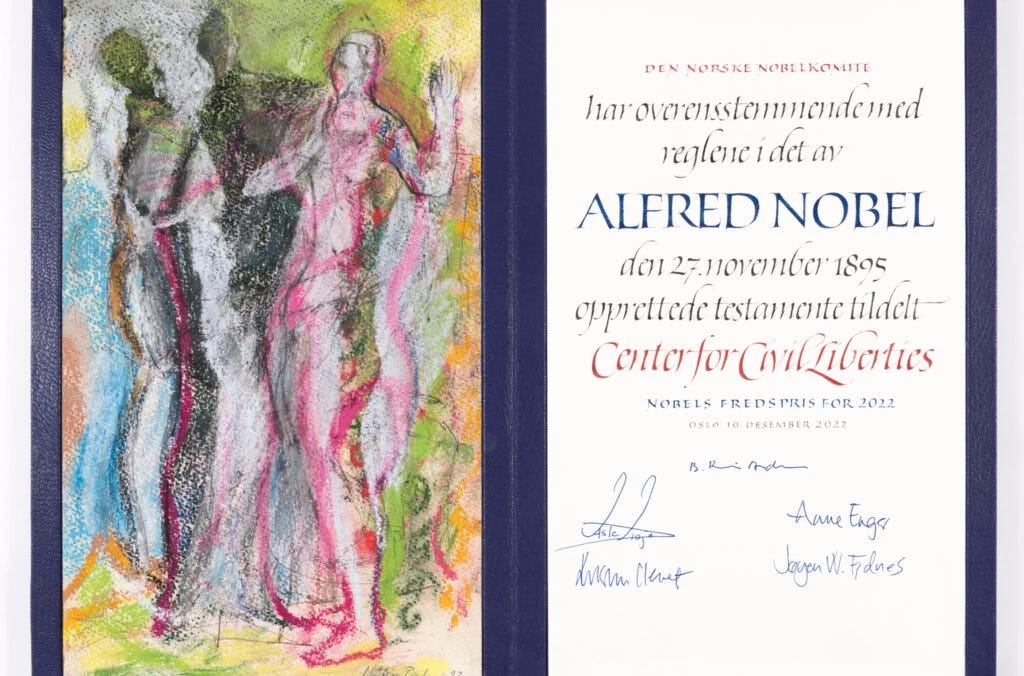Art and the Nobel Peace Prize Presentation
The emotional program captures your heart from beginning to end
The Nobel Peace Prize 2022 presentation is not to be missed. I spent a chunk of my Sunday afternoon watching the program and was touched, changed, and moved.
The program took place on Human Rights Day 12.10.22 and started with a quiet narrator setting the tone. The bells rung outside of the magnificent Oslo City Hall, signaling the start. Gorgeous heart-shaped Flamingo flowers and Siberian dogwood decorated the massive gathering area.
What is interesting about the tangible accolade that the Nobel Prize winners receive is that it contains an elaborate diploma, a cash prize (10 million Swedish kronor), and an 18K gold medal. Inside of the diploma, every year, is a unique piece of art. This year the artwork is by the famous 93-year-old Norwegian artist Håkon Bleken.
The Nobel Prize Center —
Each Nobel diploma is a unique work of art where the design is decided by the prize-awarding bodies. The literature diploma is written on parchment, i.e. specially treated leather, using largely the same technique as those of medieval book illustrators. The diplomas given to the other laureates are produced on specially ordered handmade paper.
Bleken believes that art has the ability to help us make sense of the world. “Art is there to make order out of chaos,” he says.
According to the Brandstrup art gallery —
[Bleken’s] works tell stories; of injustice, of victory and of loss. Human suffering and social activism are subjects that often reappear in Bleken's works and his work is always relevant. He revives a particular type of socio-political anxiety from the 1950s, and simultaneously, he chooses up-to-date topics of the current era. He applies art in a constant quest to find his place in life, which is reflected in his ability to continually reinvent himself as an artist. He attunes his works to the emotional details of his own life and connects them to the real socio-political world around him. The seriousness of life in his works are often contrasted with the joy of his artistic challenges, and his works have gradually become both furthermore dynamic and expressive, applied with mature and energetic brush strokes.
Of course, this art surrounds the purpose and impact of the Nobel Peace Prize, which this year is shared by two organizations and one individual — Memorial, Center for Civil Liberties, and the imprisoned Ales Bialacki. The award not only recognizes those who represent civil society in their home countries, promote the right to criticise power, and protect fundamental citizen rights, but also provides a symbol of hope.
Also in the Oslo City Hall is this massive oil painting from Henrik Sorensen:
The painting contains historic moments from the spring and summer of 1945, an important time after World War II when Norway was freed from five years of German occupation, particularly apropos for this Nobel event when the winners speak of freedom from oppressors.
Not to be missed in the presentation were four musical performances of the highest caliber, bringing tears to the audience after hearing the enlightening and passionate statements by the Laureates.
32:55 Håvard Gimse & Catharina Chen — “Estrellita” (Manuel Ponce, arr. J. Heifetz)
55:50 Marja Mortensson & Daniel Herskedal — “Máttaráhkku” (Frode Fjellheim, Inga Juuso)
1:14:00 Håvard Gimse & Catharina Chen — “Veslemøys sang” (Johan Halvorsen)
1:38:00 Anders Kjær & Astrid S — “Favorite Part of Me” (Astrid Smedplass, Jason Gill, Caroline Pennell)
Here is the full service of the ceremony and lectures of the Nobel Peace Prize Laureates. With transcripts of their profoundly important speeches here.







